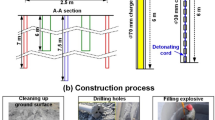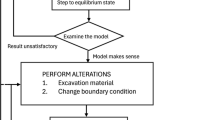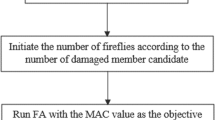Abstract
Blasting is often a necessary part of mining and construction operations, and is the most cost-effective way to break rock, but blasting generates both noise and ground vibration. In urban areas, noise and vibration have an environmental impact, and cause structural damage to nearby structures. Various wave-screening methods have been used for many years to reduce blast-induced ground vibration. However, these methods have not been quantitatively studied for their reduction effect of ground vibration. The present study focused on the quantitative assessment of the effectiveness in vibration reduction of line-drilling as a screening method using a numerical method. Two numerical methods were used to analyze the reduction effect toward ground vibration, namely, the “distinct element method” and the “non-linear hydrocode.” The distinct element method, by particle flow code in two dimensions (PFC 2D), was used for two-dimensional parametric analyses, and some cases of two-dimensional analyses were analyzed three-dimensionally using AUTODYN 3D, the program of the non-linear hydrocode. To analyze the screening effectiveness of line-drilling, parametric analyses were carried out under various conditions, with the spacing, diameter of drill holes, distance between the blasthole and line-drilling, and the number of rows of drill holes, including their arrangement, used as parameters. The screening effectiveness was assessed via a comparison of the vibration amplitude between cases both with and without screening. Also, the frequency distribution of ground motion of the two cases was investigated through fast Fourier transform (FFT), with the differences also examined. From our study, it was concluded that line-drilling as a screening method of blast-induced waves was considerably effective under certain design conditions. The design details for field application have also been proposed.














Similar content being viewed by others
References
Aydan Ö, Ulusay R, Kawamoto T (1997) Assessment of rock mass strength for underground excavations. In: Proceedings of the 36th US Symposium on Rock Mechanics, New York, June/July 1997, pp 777–786
Barton N (2002) Some new Q-value correlations to assist in site characterization and tunnel design. Int J Rock Mech Min Sci 39:185–216
Barton N, Løset F, Lien R, Lunde J (1980) Application of the Q-system in design decisions concerning dimensions and appropriate support for underground installations. Proc Int Conf Subsurface Space 2:553–561
Bieniawski ZT (1978) Determining rock mass deformability: experience from case histories. Int J Rock Mech Min Sci 15:237–247
Bieniawski ZT (1989) Engineering rock mass classifications. Wiley, New York, pp 54–55
Century Dynamics Inc. (2003) AUTODYN theory manual
Farsangi MAE, Durucan S, Kunimatsu S (1999) The effects of velocity of detonation of explosives on ground vibration in time and frequency domains. In: Proceedings of the 6th International Symposium on Rock Fragmentation by Blasting, Johannesburg, South Africa, August 1999, pp 203–206
GS Engineering & Construction (2007) Study on tunnel blasting technique for reduction of blast-induced vibration in urban areas. GS Construction Technology Institute Report R1-200
Hamashima H, Kato Y, Itoh S (2004) Determination of JWL parameters for non-ideal explosive. In: Proceedings of the 13th American Physical Society (APS) Topical Conference on Shock Compression of Condensed Matter (AIP Conference Proceedings 706), Portland, Oregon, September 2003, pp 331–334
Itasca Consulting Group, Inc. (2002) PFC2D (Particle Flow Code in 2 Dimensions) manuals
Jiang J (1993) Vibration due to a buried explosive source. PhD dissertation, Western Australian School of Mines, Australia
Jimeno CL, Jimeno EL, Carcedo FJA (1995) Drilling and blasting of rocks. AA Balkema, Rotterdam, 100 pp
Jong YH (2006) Numerical estimation of excavation damaged zone by blasting. PhD dissertation, Seoul National University, Korea
Konya CJ, Walter EJ (1991) Rock blasting and overbreak control. FHWA-HI-92-001, National Highway Institute, 5 pp
Lee E, Finger M, Collins W (1973) JWL equation of state coefficients for high explosives. UCID-16189, Lawrence Livermore National Laboratory
Lucy LB (1977) Numerical approach to the testing of the fission hypothesis. Astron J 82(12):1013–1024
Palmström A, Nilsen B (2000) Engineering geology and rock engineering. Handbook no. 2. Norwegian Rock Mechanics Group, Norwegian Soil and Rock Engineering Association, 140 pp
Park BK, Lee IM, Kim SG, Lee SD, Cho KH (2004) Probabilistic estimation of fully coupled blasting pressure transmitted to rock mass. II: Estimation of rise time. Tunnelling Technol 6(1):25–39
Riedel W, Thoma K, Hiermaier S (1999) Numerical analysis using a new macroscopic concrete model for hydrocodes. In: Proceedings of the 9th International Symposium on Interaction of the Effects of Munitions with Structures, Berlin, Germany, May 1999, pp 315–322
Serafim JL, Pereira JP (1983) Consideration of the geomechanics classification of Bieniawski. In: Proceedings of the International Symposium on Engineering Geology and Underground Construction, Lisbon, Portugal, September 1983, vol 1, pp II.33–II.42
Starfield AM, Pugliese JM (1968) Compression waves generated in rock by cylindrical explosive charges: a comparison between a computer model and field measurements. Int J Rock Mech Min Sci 5:65–77
Tang PK, Hixson RS, Fritz JN (1997) Modeling PBX 9501 overdriven release experiments. In: Proceedings of the 10th American Physical Society (APS) Topical Group Conference on Shock Compression of Condensed Matter (AIP Conference Proceedings 429), Amherst, Massachusetts, July/August 1997, pp 365–368
Wang Z, Lu Y, Hao H, Chong K (2005) A full coupled numerical analysis approach for buried structures subjected to subsurface blast. Comp Struct 83:339–356
Woods RD (1968) Screening of surface waves in soils. J Soil Mech Found Div 94(SM 4):951–979
Acknowledgments
The financial support for this work was provided by GS Engineering & Construction. The authors would like to thank Dr. S. M. Na and Mr. H. D. Min for the help given during the preparation of the work.
Author information
Authors and Affiliations
Corresponding author
Appendix: RHT Model Equations
Appendix: RHT Model Equations
The equation of state (EOS) of the fully compacted material:
where P is the pressure, A 1, A 2, A 3, B 0, B 1, T 1, and T 2 constants, ρ the density, ρ 0 the initial density, and e is the specific internal energy.
The EOS of the porous material:
where α is the porosity, α init the initial porosity, P lock the initial compaction pressure, P crush the solid compaction pressure, and n is the compaction exponent.
The failure surface:
where Y fail is the failure surface, Y TXC(P) the compression meridian, έ the strain rate, F Rate(έ) the strain rate function, α and δ the material constants, R 3(θ) a function of an angle rotating around the hydrostatic axis and meridian ratio Q, f c the compressive strength, A the failure surface constant, N the failure surface exponent, P* the pressure normalized by f c, and P*spall = P* (f t/f c).
The elastic limit surface:
where F elastic is the ratio of the elastic strength to failure surface strength and F CAP(P) is a function that limits the elastic deviatoric stresses under hydrostatic compression.
The residual failure surface:
where B is the residual failure surface constant and M is the residual failure surface exponent.
The damage model:
where D, D 1, and D 2 are damage constants, Δε pl the accumulated plastic strain, ε failure p the failure strain, and G initial, G residual, and G fracture are the shear moduli of the initial, residual, and post-damage, respectively.
Rights and permissions
About this article
Cite this article
Park, D., Jeon, B. & Jeon, S. A Numerical Study on the Screening of Blast-Induced Waves for Reducing Ground Vibration. Rock Mech Rock Eng 42, 449–473 (2009). https://doi.org/10.1007/s00603-008-0016-y
Received:
Accepted:
Published:
Issue Date:
DOI: https://doi.org/10.1007/s00603-008-0016-y




